
Without quality bug and crash reporting tools such as Instabug, the software development industry as we know it would be unimaginable.
It’s one of the most popular and widely-used types of software that not only enables rapid bug detection and reporting, but also contains numerous other advanced features that facilitate the debugging process.
It’s essential to note, however, that Instabug is not the only option on the market and that there are a myriad of other tools that can be formidable competitors.
That is why, in this article, we’ll explore nine top alternatives to Instabug that may better suit the needs and requirements of your team.
Let’s dive in and explore them!
Table of Contents
Shake
Shake is a remarkable tool for reporting bugs and crashes that gives Instabug a run for its money.
What distinguishes Shake is its unique blend of features, user-friendliness, and affordability.
The tool’s name derives from its most prominent feature, shake to report, which enables Android and iOS users to quickly report crashes and bugs by shaking their phones.
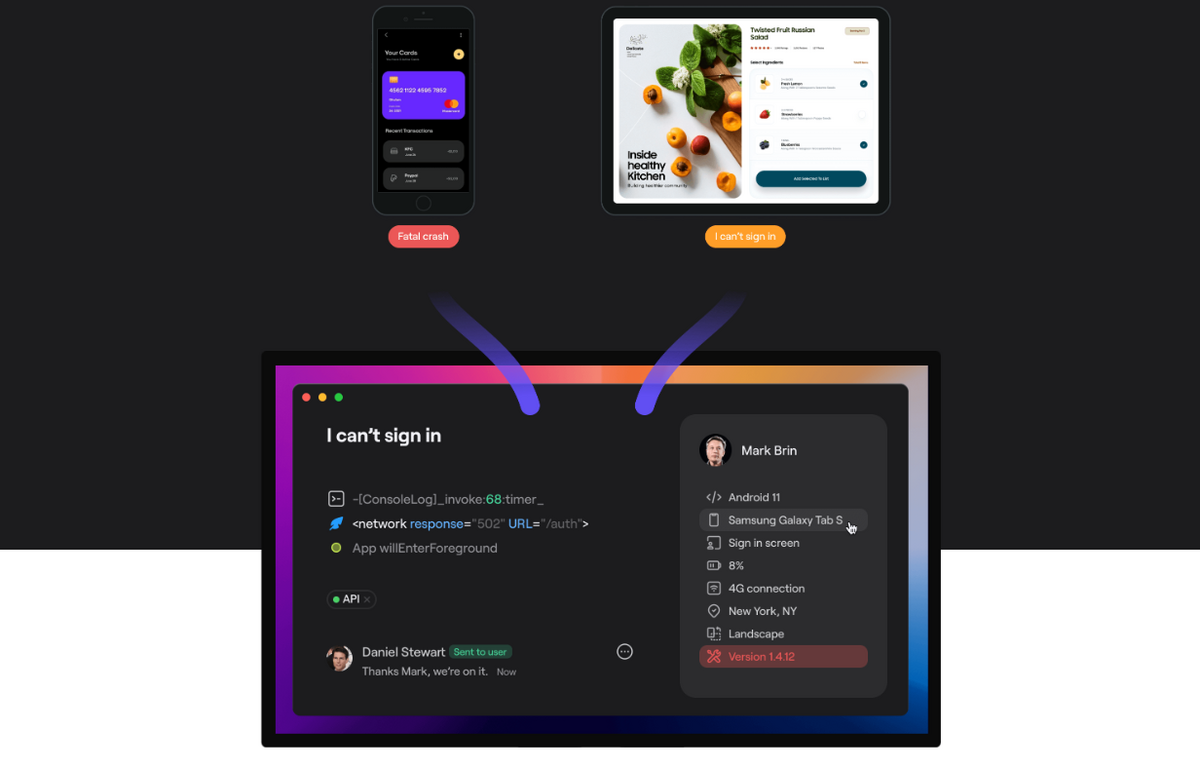
Once initiated, the tool automatically generates a bug report containing over 70 distinct pieces of data that provide ample information to you and your team regarding the issue at hand.
That is due to Shake’s black box, similar to those found on airplanes, which records the app’s activity 60 seconds before the bug is reported, allowing developers to recreate the bug’s environment and resolve the issue more efficiently.
Additionally, Shake allows you to customize the tool to match your app’s design, a feature that Instabug lacks, and enables you to create your own ticket reporting form so it fits the requirements of your team.

Shake offers three pricing plans (Starter, Professional, and Organization), and each includes everything provided by the service, with no hidden fees or requirements to purchase another plan to access all features.
However, one of Shake’s best features is the fact that it offers unlimited seats, which allows you to invite all team members to use the tool without paying for each individual subscription.
The sessions are also unlimited.

Get unreal data to fix real issues in your app & web.
In contrast, Instabug’s Standard plan allows six free seats, and each additional user costs an extra $60, which can be a significant expense for large teams.
Additionally, if you decide to move to Shake midway through your Instabug yearly plan, Shake will provide you with credits to your Shake workspace in the amount of the remaining time on your Instabug subscription.
All in all, Shake is undoubtedly one of the best and most affordable alternatives to Instabug, and it’s definitely worth taking into consideration.
BugHerd
It can be tough to keep track of all the feedback and contributions from the numerous stakeholders engaged in a web project, from developers and QA testers to clients.
This is where BugHerd can help.
It’s a project management and issue-tracking tool that allows you to visually track comments and input from all of these parties.
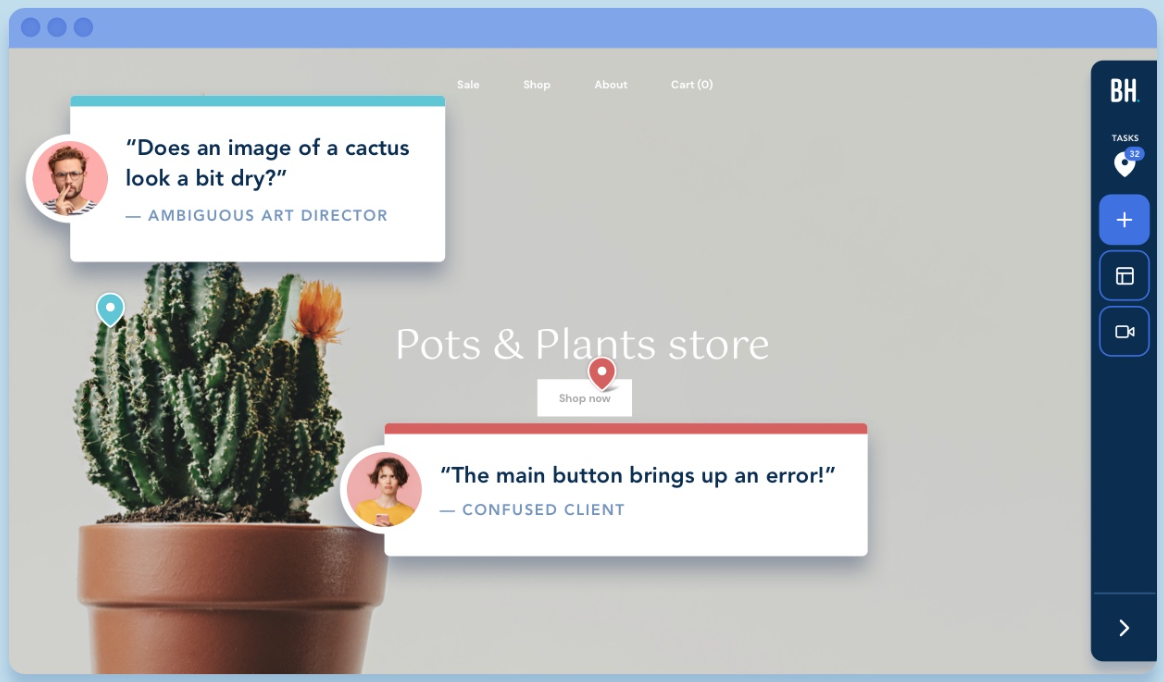
This is because it enables them to report bugs directly in the browser by simply clicking on the element causing the problem.
All of this data is then immediately sent to a Kanban-style board, where you can assign tasks to team members and track their progress.
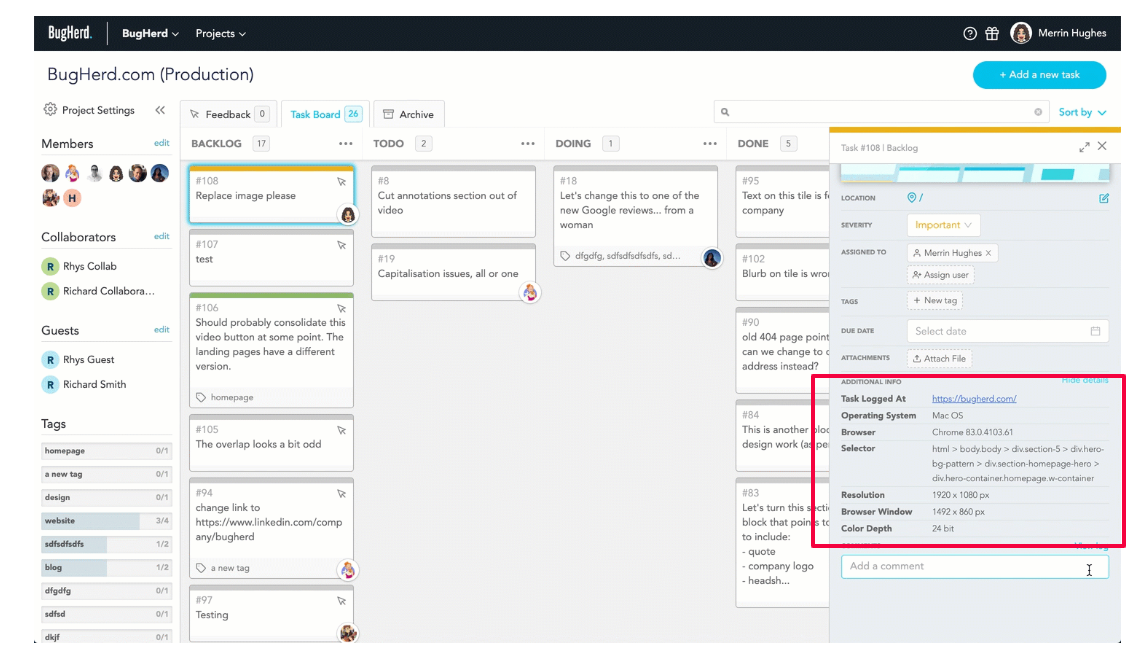
Because BugHerd collects technical information regarding defects, such as the operating system, browser version, screen specifications, and more, it will display this information on the board, too, making it easier to fix incidents.
Therefore, if you work mostly on web development projects, BugHerd is a good alternative to Instabug, primarily because Instabug is a mobile-focused solution.
BugHerd offers five affordable pricing plans, so everyone can choose the one that best suits their budget and requirements.
A 14-day trial version is also available, allowing you to test the tool before purchasing it.
Overall, BugHerd is an excellent tool for gaining a visual understanding of all the bugs and other issues on your website, which also allows all stakeholders to collaborate successfully.
BugSnag
Bugsnag is another tool that can be a great substitute for Instabug when it comes to error monitoring and reporting.
It provides numerous useful pieces of information, such as breadcrumbs (shown in the picture below), stack traces, and environment data, all of which help identify the source of issues.
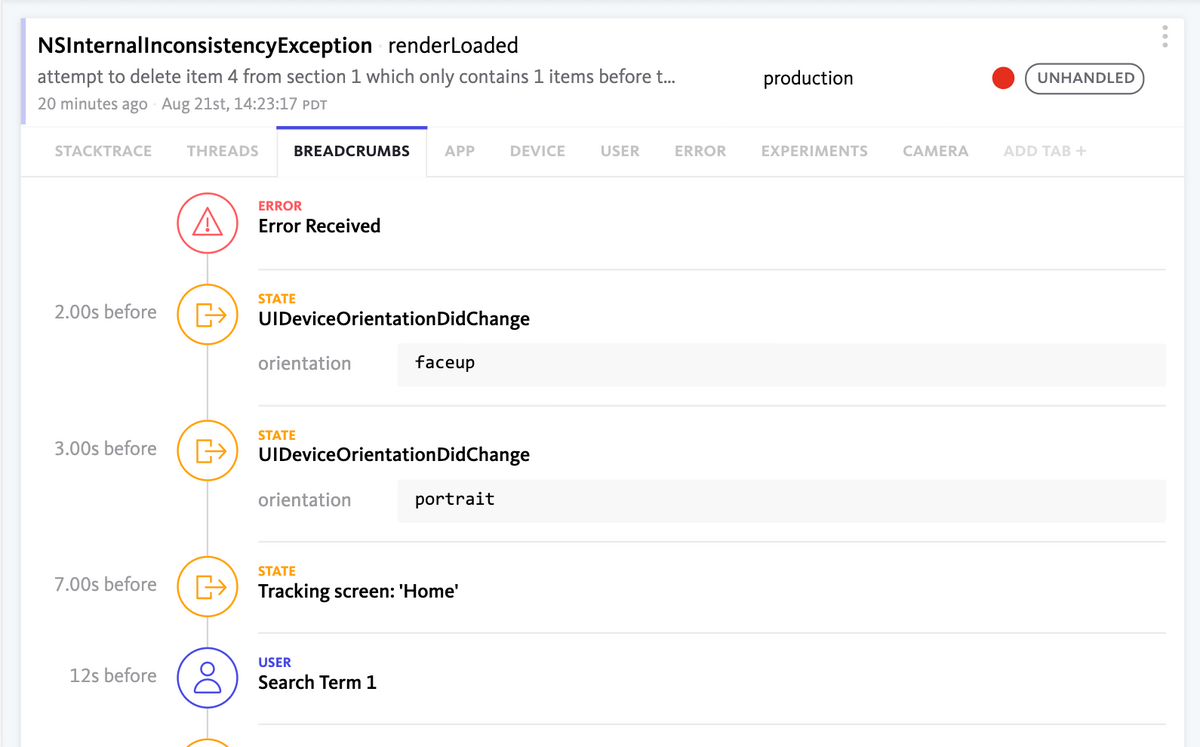
Additionally, the tool can acquire different diagnostic data, including unhandled exceptions and environment data, which can prove invaluable during the debugging process.
As such, it gives precise information on crashes and other anomalies, which enables developers to better record and analyze bug reports coming from desktop, mobile, and web apps.
On the other hand, while Bugsnag only lists steps that led to an error, Instabug captures screenshots and video recordings of the bug, reproduction steps, and detailed logs, which can facilitate bug reporting.
Moreover, just like Shake, Instabug has black box features, capturing all device-related metrics 60 minutes before the bug is reported, a feature that Bugsnag lacks.
Bugsnag’s pricing model is based on the number of events tracked, which means that, as in Instabug’s case, the price can rapidly increase when it comes to more complex projects.
Nevertheless, if you are looking for a top-notch monitoring tool that will enable you to keep track of all bugs, Bugsnag can be an excellent option, even though it doesn’t have all the features of Instabug.

Bugsee
Just like Shake, Bugsee is a bug and crash reporting tool that can be Instabug’s worthy rival.
One of the significant advantages of Bugsee is its straightforward installation process, which requires adding just one line of code.
After installation, users can report bugs by capturing a screenshot, and the tool will generate the bug report automatically, which is different from Instabug’s shake-to-report functionality.
As depicted in the picture below, Bugsee’s dashboard has a video playback feature that reveals what users were doing when the app crashed, as well as technical details like device specification, OS versions, screen size, and other relevant information.
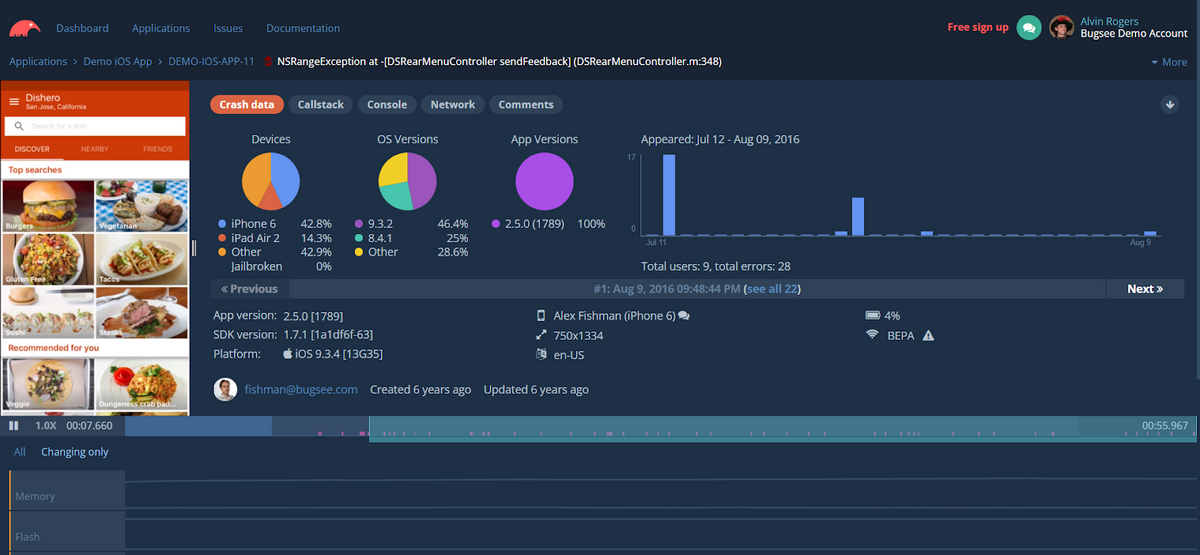
Although these are the features that Instabug also possesses, and they have already become industry standards, Bugsee’s dashboard is clearly superior in terms of visual organization and usability, making it more user-friendly than Instabug.
Bugsee offers three pricing tiers: Lite, Pro, and Custom. The Lite plan is free but can only be used on five unique devices.
In other words, if you need to use it on more than five unique devices, you’ll have to upgrade to the Pro or Custom plan.
The Pro plan offers 50 unique devices per month, which is a disadvantage compared to Shake, which, for example, allows 10,000 unique devices across all plans.
However, Instabug is also pretty pricey, and the costs increase with bigger projects and more users, so both tools aren’t the most affordable solution.
Nonetheless, Bugsee is a sophisticated tool with an excellent interface, and you should strongly consider it if Instabug no longer meets your needs.
LogRocket
LogRocket is another tool that deserves to be on our list for many reasons.
As a tool for error monitoring and issue management, it helps you rectify bugs and understand user behavior by capturing logs and session recordings from your web and native mobile apps.
Simply put, LogRocket will display the most significant errors that affect your users and enable you to determine their root causes by reviewing video recordings, console logs, and network logs for each bug report.
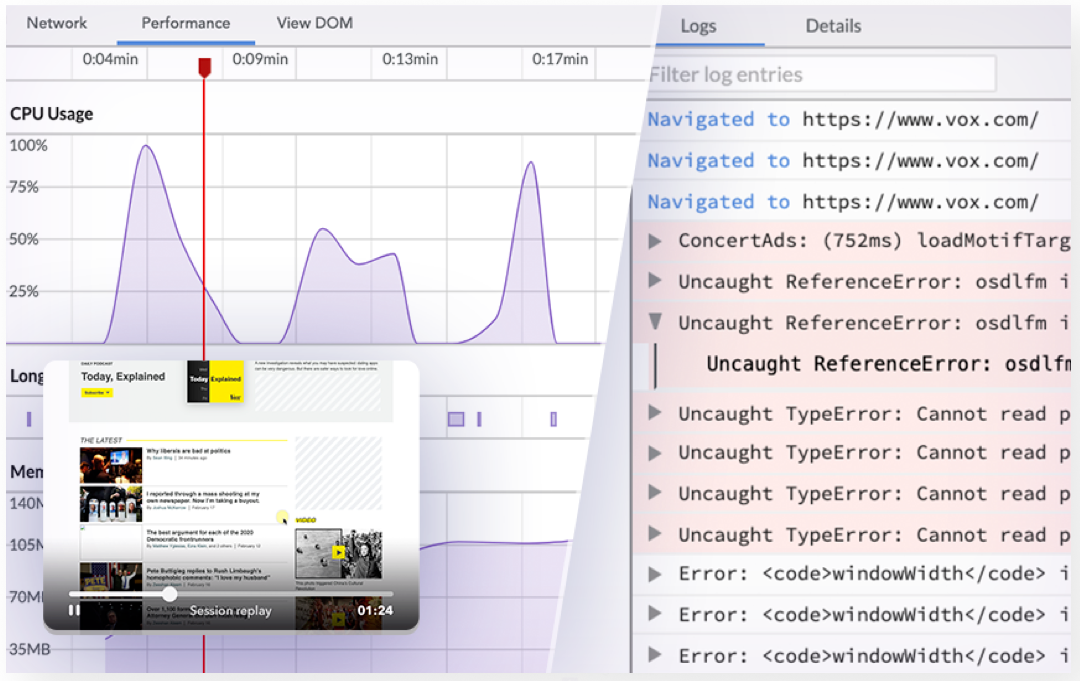
However, what sets LogRocket apart from Instabug and similar tools on the market are its truly advanced search capabilities.
You can search and filter by events. For example, you can ask the tool to show you users who went through the onboarding process but did not convert.
You can also search sessions by properties such as user email, name, login date, location, status, duration, visited page, and much more.
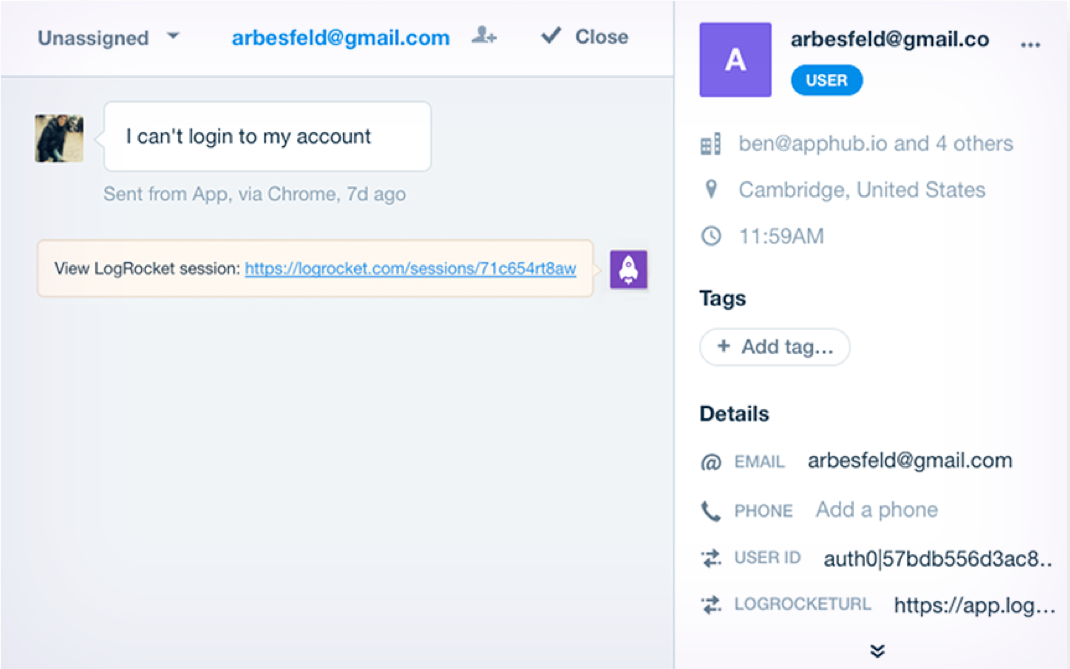
In simple terms, if it occurred in your app, chances are you can find it with the LogRocket search feature.
As for pricing, LogRocket offers four plans: Free, Team, Professional, and Enterprise.
Since it has a free option, you can evaluate the tool and its 1,000 monthly sessions to determine if it’s what your team needs.
Other pricing plans are based on the number of sessions, starting with the Team plan that costs $99 and offers 10,000 sessions, so if you have a larger team and more demanding projects, you may need to upgrade to another option.
All things considered, LogRocket is a fantastic alternative to Instabug due to its advanced error search and filtering capabilities, as well as the fact that it records detailed video sessions so that you can always pinpoint where an error occurred.
New Relic
New Relic is a monitoring software that provides real-time tracking of application performance.
It offers a comprehensive dashboard that gives insights into various aspects of the app and enables you to monitor your frontend, backend, infrastructure, vulnerabilities, and logs.
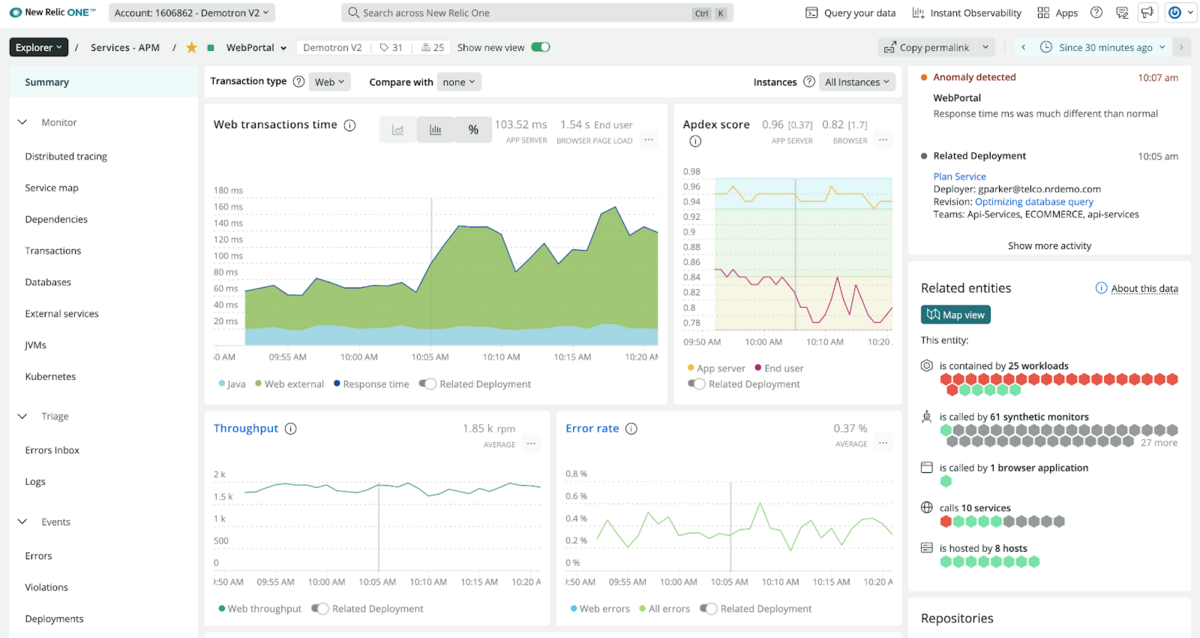
In other words, with New Relic, developers can obtain valuable data on both frontend and backend performance metrics, making it simpler to troubleshoot crashes and other issues.
Apart from crash monitoring, New Relic also offers application performance monitoring (APM), infrastructure monitoring, browser monitoring, and synthetic monitoring.
That’s why it’s primarily used by Backend and DevOps teams that require a reliable tool to obtain end-to-end insights into the app’s performance.
In contrast, Instabug is built with mobile developers in mind.
Recently, New Relic has introduced a brand new feature named New Relic Grok, the generative AI assistant for observability.
This groundbreaking feature will undoubtedly attract a large number of development teams because they can now ask New Relic Grok, in plain language, to improve alert coverage, add a new user or team member, detect and resolve issues, and summarize problems, among other things.
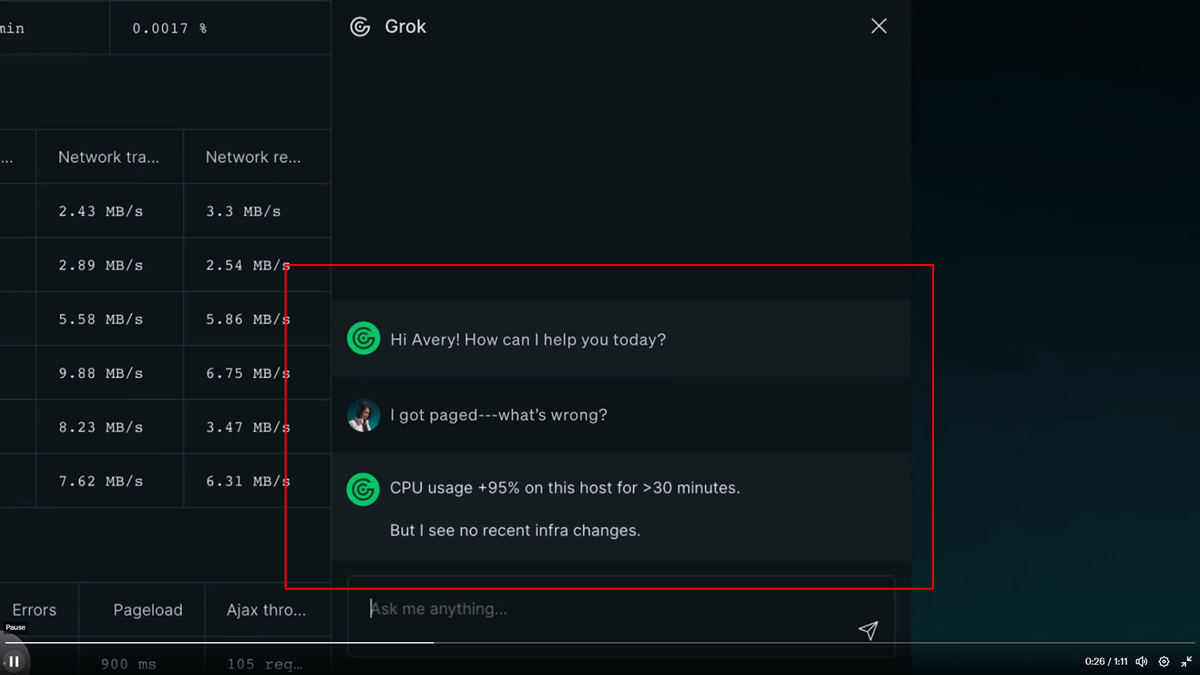
This expedites the whole process and introduces AI-generated chats into the error monitoring tools.
However, one major downside of New Relic is its complex price system, which depends on various criteria and might make accurate cost estimation difficult.
Therefore, before committing to this option, you should research its potential costs.
Still, New Relic remains an excellent tool for developers who wish to effortlessly troubleshoot and enhance application performance.
Raygun
Raygun is another interesting alternative to Instabug that you should strongly consider employing.
The platform integrates error monitoring, crash reporting, and application performance monitoring (APM) features in one central location.
As shown in the image below, Raygun offers developers of web and mobile apps access to detailed crash reports.
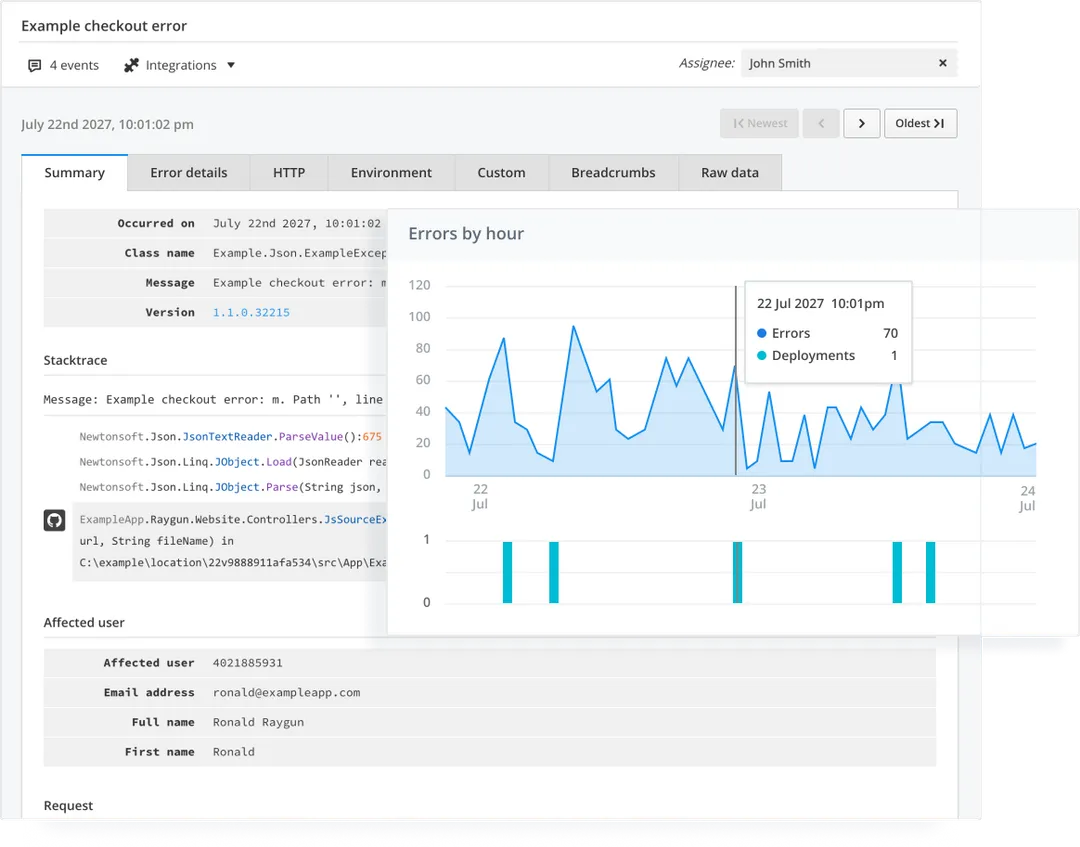
These reports contain information about the nature of the issue, the exact line of code that was being executed, a complete stack trace, environment data, and any other pertinent information regarding what led to the error.
With this information, developers can determine the cause of a crash and quickly implement a solution.
In addition to this, Raygun also gives users a glimpse of the performance of the server at the code level.
Developers can use this to identify slowdowns and other performance issues that can subsequently be addressed and improved.
Its crash reporting plan, which costs $40 per month for up to 100,000 errors and covers unlimited applications and team members, is an economical alternative to Instabug in terms of pricing.
This makes it an attractive option for development teams that are looking for a powerful yet reasonably-priced tool.
Rollbar
Rollbar is a powerful error monitoring tool that can help you enhance your app’s functionality by detecting, prioritizing, and resolving bugs and crashes.
It accomplishes this by integrating with multiple programming languages, frameworks, and platforms to monitor and aggregate errors and exceptions in real time, whether in development or production environments.
Using Rollbar, you can address issues as they arise by receiving instant alerts for all errors, ensuring that no issue is overlooked.
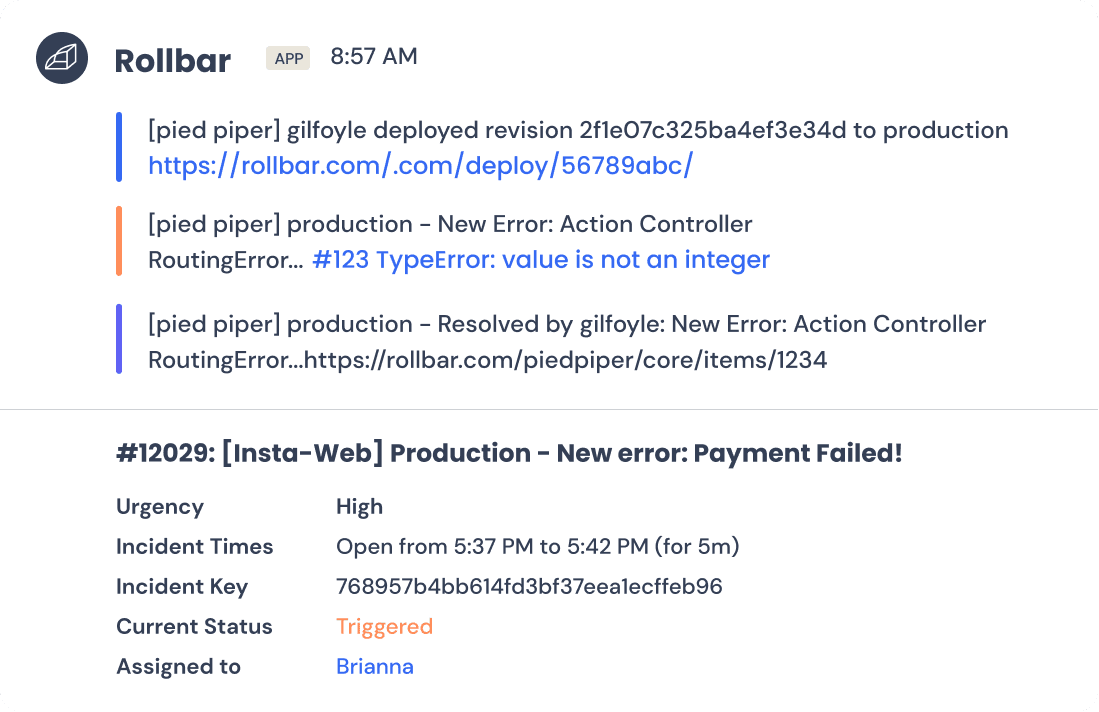
Rollbar also uses AI and machine learning to group similar errors, thereby reducing false alarms and highlighting only significant issues.
It’s worth mentioning that Rollbar is also a platform for continuous code improvement, which is one of its most distinguishing characteristics compared to Instabug.
In other words, if you regularly deploy code to production or have multiple versions running, Rollbar will display errors that occurred in each deployed version, allowing you to monitor the quality of each version over time, as shown below.
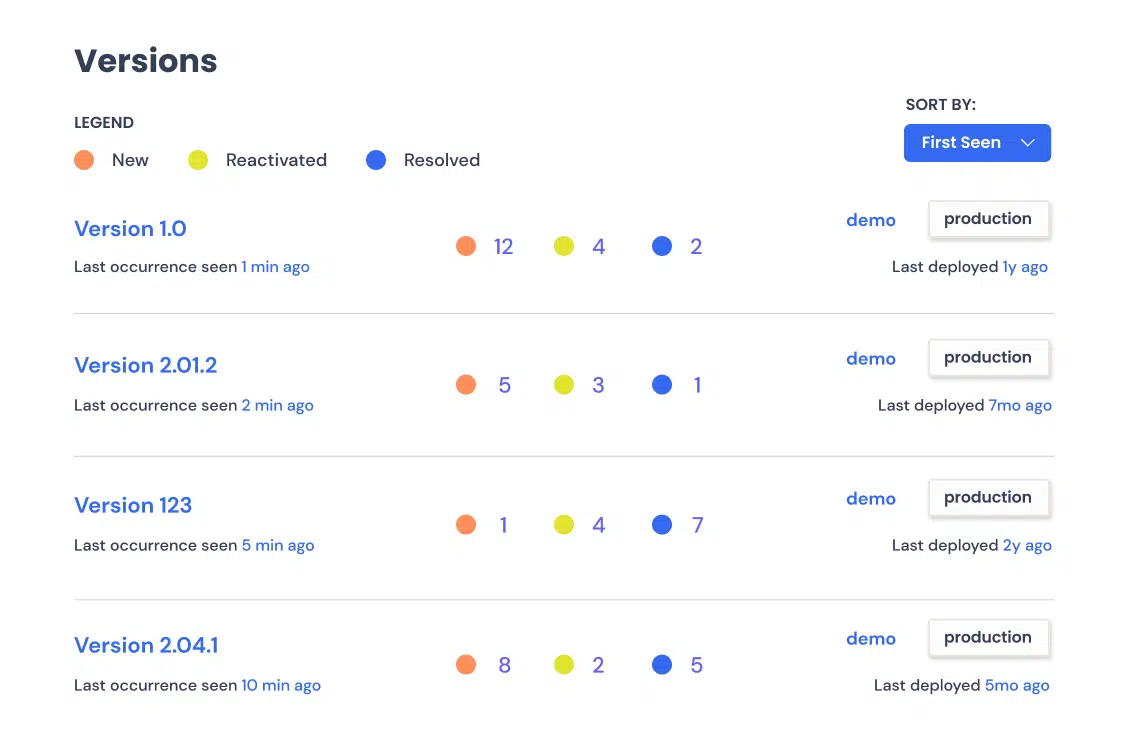
Rollbar offers multiple pricing plans, ranging from a free version with basic error-tracking capabilities to the Enterprise plan with more advanced features.
These plans are reasonably priced, making them a good option for all teams, even smaller ones.
In summary, Rollbar is a great option for anyone who works with multiple programming languages and platforms, deploys code frequently, and requires a cost-effective error-monitoring system. In that sense, it’s more than a worthy substitute for Instabug.
Sentry
Last but not least, Sentry is another widely used error-tracking platform that enables developers to keep tabs on and fix bugs as they arise in real time.
It’s an open-source tool that supports more than 30 programming languages and can assist you in diagnosing, repairing, and boosting your code’s performance.
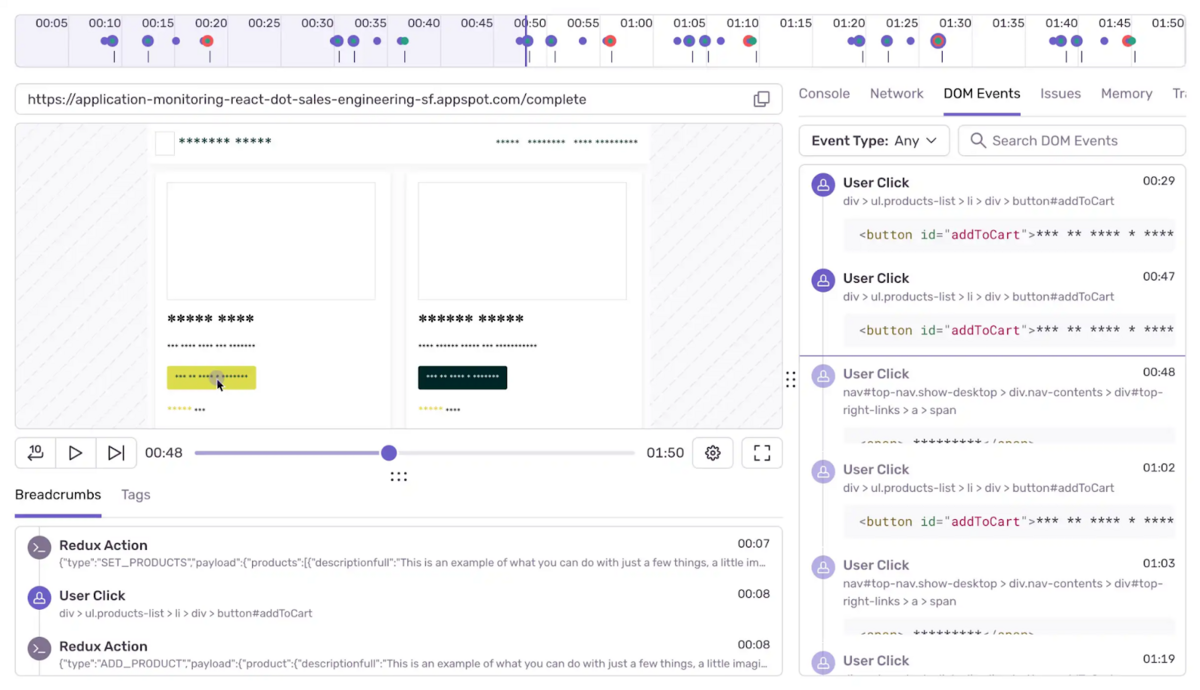
Sentry’s ability to combine the stack trace and the source code when displaying issues is a great feature because it makes it simple to pinpoint the issue directly without having to sift through the codebase.
Sentry also offers other helpful features such as release tracking, performance monitoring, and user feedback capture, making it a versatile tool that can be used for web and mobile applications.

Very handy for handling user feedback. CTOs, devs, testers – rejoice.
In contrast, Instabug is a more specialized tool that primarily focuses on mobile apps and bug and crash reporting.
In terms of pricing, even though Sentry provides a free plan, its pricing structure is based on the number of events captured, which may present a challenge for companies that generate a lot of events.
Nevertheless, the wide range of integrations and advanced features make Sentry a comprehensive solution and a great Instabug alternative.
Conclusion
No doubt about it, Instabug is a powerful tool when it comes to reporting bugs and crashes, and it’s the go-to choice for many development teams across the globe.
But that doesn’t mean you should limit yourself to just one option.
After all, exploring other similar tools can help you make an informed decision on the best fit for your needs, taking into account factors like pricing, functionality, debugging, and additional features.
Hopefully, this article sheds some light on some of the top-notch alternatives to Instabug out there and will help you find the ideal solution for your team.






